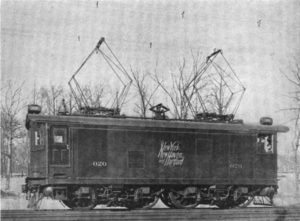New Haven EP-1
| New Haven EP-1 | |
|---|---|
|
EP-1 of the New York, New Haven and Hartford Railroad , in the middle the small pantograph for DC voltage operation (1907)
|
|
| Number: | 41 |
| Manufacturer: | Baldwin - Westinghouse |
| Year of construction (s): | 1905-1908 |
| Axis formula : | Bo'Bo ' |
| Gauge : | 1435 mm ( standard gauge ) |
| Length over buffers: | 11,443 mm |
| Service mass: | 93 t |
| Top speed: | 130 km / h |
| Hourly output : | 1060 kW |
The EP-1 was a series of electric boxcab locomotives that could be operated as two-system locomotives with direct current on a conductor rail as well as with alternating current under an overhead line . The machines built by Baldwin were created with the assistance of Westinghouse Electric Corporation and were the first of their kind. The name EP, which was introduced later, stood for "Electric Passenger".
prehistory
The tracks to the terminus Grand Central Station (since 1913: Grand Central Terminal ) in the Manhattan borough of New York City lay in a four-kilometer underground section from which the authorities wanted to ban steam operations as early as 1902 . Poor visibility in the smoke-filled tunnel led to a railway accident in February of that year with 15 dead and 41 injured. The conversion to electrical operation was required by law by July 1, 1908.
Approached was the station of the trains of the railway company New York Central and Hudson River Railroad (NYC & HR, later in the New York Central Railroad merged), which tracks the New York, New Haven and Hartford Railroad also called (NYNH & HR, "New Haven" ) used. At the end of September 1906, the first section between Grand Central and High Bridge ( Harlem ) was electrified with side busbars and 650 V DC . The locomotives were changed at High Bridge station. Soon after, electrical operations were expanded to Mott Haven, just under 20 km from Grand Central Station.
In order to be able to reach the major New York stations without changing locomotives , the companies procured multi-system locomotives and multiple units for two or even three power systems. An early example of this is New Haven's EP-1, of which 41 locomotives were built between 1905 and 1908.
history
NYC & HR limited itself to equipping the above-ground routes leading out of New York City with conductor rails. At the beginning of 1913 the planned length of approx. 100 km was reached. The New York, New Haven and Hartford Railroad had been able to gain experience with electrical operation since 1895: Several of their branch lines, which functioned as rural railways, were operated with direct voltage from overhead lines. For their line from Mott Haven Junction from NYC & HR, they decided to use overhead line operation, which was the first time in the USA that alternating current with the highest possible voltage was to be used. The cost of electrification promised to be only about half as high as for the busbar system, with the lower need for substations being a major factor.
From the rivalry between General Electric - the Thomas Alva Edisons company , New Haven wanted to make the proven and technically simple direct current system attractive - and Westinghouse emerged victorious from the latter. The line was electrified with an alternating voltage of 11,000 V and a frequency of 25 Hz. The railway ordered 35 dual-system locomotives (EP-1 series), which could be supplied with alternating voltage via pantographs or with direct voltage via sliding contacts .
The EP 1 had the axle formula Bo'Bo 'and a driver's cab at each end of the vehicle. They were built between 1906 and 1907 and went into operation in 1907 after Westinghouse had delivered a first prototype in 1905 . In 1908, New Haven ordered six more machines. Since NYC & HR had provided routes with direct current overhead lines instead of busbars, the locomotives received a third, smaller pantograph for direct current operation. They weighed 93 t and were 11,443 mm long with a coupling. The maximum speed of the 1060 kW machines was 130 km / h. Since the large, low-lying and unsprung masses of the Tatzlager motors caused damage to the tracks, the locomotives were subsequently given leading axles on both sides (the axle order changed to (1'Bo) (Bo1 ')), which did not solve the problem.
A security system in the locomotive prevented electricity from being drawn from several sources at the same time. It was possible to switch between the power systems while driving. The machines were capable of multiple traction and were the first electric locomotives to use this option in regular operation. They pulled passenger trains between New York City and Stamford at first , after the expansion of the electrical network they continued to New Haven .
In 1936, the New Haven parked the first of these machines, but the last remained in service until 1947. The successor series was the EP-2 , which was built from 1919 and was used until 1958.
Web links
Individual evidence
- ↑ a b c d Stefan Vockrodt: Electric to Manhattan . In: Railway history special . Railways in New York No. 1 , 2013, ISBN 978-3-937189-77-2 , pp. 50 ff .

